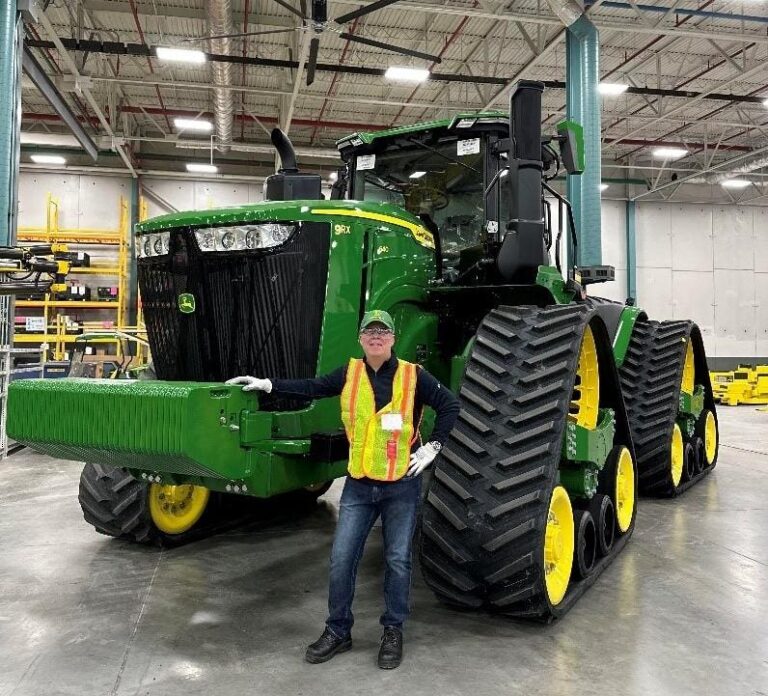Will Townsend, John Deere Connected Factory, Waterloo, Iowa — March 2024
I recently toured two John Deere facilities in the heart of the Midwest. The company’s roots date back to 1837, when the blacksmith for whom the company is named developed the first self-sharpening steel plow, which revolutionized agriculture at the time. Nearly 190 years later, John Deere continues to innovate on many fronts.
A visit to the company’s Tractor & Engine Museum and 5G-connected factory in Waterloo, Iowa, was an eye-opening experience. In this article, we discuss how the company is leveraging cellular connectivity to enable automation and autonomy for its iconic green and yellow vehicles, and using 5G to drive efficiency within the factories that produce those vehicles.
Modern manufacturing with 5G
You might not immediately associate an agriculture brand like John Deere with cutting-edge technology, but you’d be wrong. The company has opened research facilities and laboratories in Iowa, as well as in tech hotspots like Austin and San Francisco. Additionally, Deere’s acquisitions, such as Blue River Technology, bring together top talent and technology in computer vision, machine learning, AI, cloud-native infrastructure, and more to revolutionize agricultural operations. Add in Deere’s significant research and development spending, which totals billions of dollars annually, and you see an impressive commitment to making agriculture smarter.
The same can be said about Deere’s early recognition of the power of private 5G communications. In 2020, the company began its 5G deployment journey by obtaining a dedicated spectrum license through the Citizens Broadband Wireless Service managed by the Ongo Alliance. Not wanting to rely on a third party to design, deploy, and operate its cellular network, Deere opted to build an in-house team of network engineers to work with Nokia. They completed their initial work in record time, taking just six weeks to launch a production network. From my perspective, the decision to build an in-house team and the subsequent astonishingly fast execution speak to the company’s confidence in its technological capabilities and its desire to accelerate the vertical integration of its manufacturing processes.
The manufacturing use cases that have benefited from Deere’s investment in a private 5G network are noteworthy. To date, the company has deployed more than 100 automated guided vehicles controlled via 5G to move engines, drivetrains, cabs, wheels, and other parts through the assembly process. Leveraging 5G’s ultra-low latency and high data throughput, computer vision is being used to inspect welds for quality control and monitor worker safety. Finally, 5G connectivity is enabling Deere to improve assembly line processes. It can help with focused tasks like wirelessly measuring torque levels on power tools to ensure optimal workflow, or it can be applied more broadly to reconfigure assembly lines in hours instead of days or weeks to maximize operational efficiency.
Why 5G and not Wi-Fi?
One might ask why John Deere chose 5G cellular connectivity over Wi-Fi and its attendant “free” underlying unlicensed spectrum. The answer to that question is manifold. 5G cellular connectivity is inherently more deterministic than Wi-Fi due to smoother radio-to-radio handoffs. 5G can also support far more devices per radio. Deere reports supporting up to 800 devices per radio within its private 5G cellular network. This contrasts with the company’s previous experience where a single Wi-Fi access point could only handle 50 devices. In operational technology environments like Deere’s, industrial IoT deployments will significantly increase the number of devices connecting to the network for scenarios such as predictive maintenance. The economics associated with densifying Wi-Fi to address these needs will soon grow beyond reach. As a bonus, 5G’s architectural design will provide stronger encryption and a better security posture than Wi-Fi. This is an important consideration given the expanding attack surface and vulnerabilities that often come with large-scale IoT deployments.
In addition to its technical and security capabilities, 5G offers fiber-like throughput and latency profile, allowing for greater flexibility in installation and access. For example, wiring Ethernet to overhead connected devices such as cranes, hoists and smart cameras is often impractical but can be easily achieved with 5G. Additionally, the cellular spectrum can propagate over larger areas, both indoors and outdoors, providing more reliable connectivity for moving objects. This is especially relevant for manufacturing workflows such as yard management, operational audits, rollover testing and trailer tracking.
summary
The way I see it, John Deere is committed to 5G to gain a competitive advantage in manufacturing the most technologically advanced, safe and reliable agricultural equipment that contributes to feeding the world – an initiative that firmly reflects the company’s core values of integrity, quality, responsibility and innovation.
It’s clear that 5G’s deployment flexibility, high-speed throughput and ultra-low latency are improving Deere’s ability to process data, analyze and deliver actionable insights in near real time, optimizing its manufacturing processes and creating new value. The company is a pioneer in using cellular connectivity to accelerate its digital transformation efforts and modernize its manufacturing processes, and other world-class manufacturers should consider doing the same.


